The Best Disney Games Of All Time
The House of Mouse is home to some of the most iconic characters in the world. Here are some of Disney's best video game adaptations.
Disney has some of the most recognizable characters in the world, and it's regularly putting out new movies and TV series that immediately create pop culture icons. The likes of Mickey Mouse, Minnie, Donald, and Goofy have been progressively joined by a wide variety of other great and memorable characters, whether it's from TV shows like Darkwing Duck and Gargoyles or its prestige array of big-screen fairy tale adaptations like The Little Mermaid and Cinderella. And where there's valuable, beloved characters, there will be adaptations into other mediums like books, toys, and of course, video games.
There have been countless Disney video games produced through the years, so a look back shows a microcosm of game development as a whole. Though the House of Mouse's game output has slowed from its heyday during the 8- and 16-bit eras, there are still gems to be found, and more coming all the time. Here are some of the best Disney games of all time, listed from oldest to newest.
If you're looking for even more games to play with kids, be sure to check out our 15 great games parents need to play with kids, best Switch games for kids, and the best family games of 2021 as rated by Metacritic.
Ducktales - 1989

One of Disney's earliest licensed games is also one of its absolute best. Ducktales (awoo oo) was one of several Capcom games based on popular Disney movies and TV shows. While all of these games were at least pretty good, Ducktales is still the crowning achievement of this partnership. Scrooge's suite of abilities--the cane pogo and ability to whack static boxes and ricochet them into other items--was unlike anything else on the market and felt naturalistic and satisfying like a Mega Man game. On top of that, the music was absolutely stellar, and is still immortalized in covers. One song even got an Easter egg callback in the rebooted Ducktales cartoon series.
Ducktales was followed by a sequel, Ducktales 2, along with a remastered version in 2013. Both of those were fine, but for pure nostalgic excellence, you can't beat the original.
Chip 'n Dale's Rescue Rangers - 1990
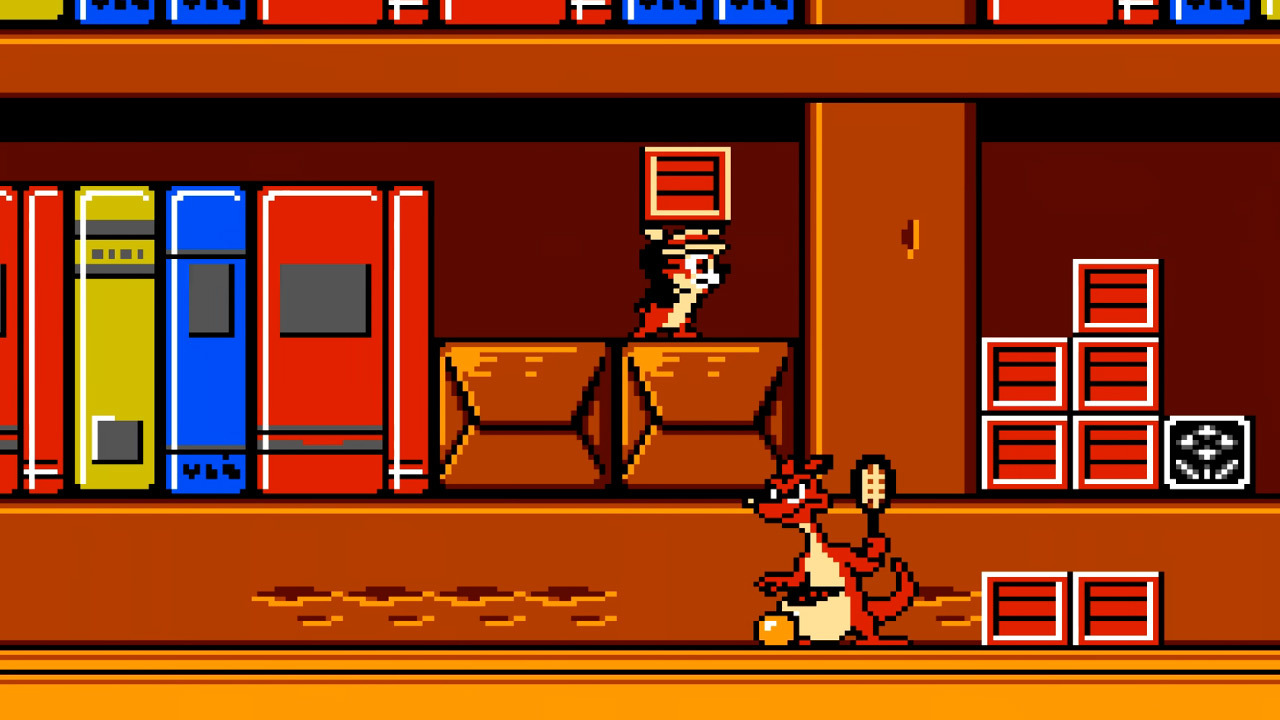
Chip 'n Dale's Rescue Rangers took the classic chipmunk duo and turned them into adventuring heroes. Similarly, this video game adaptation had the pair side-scrolling their way through stages to rescue their mechanic friend Gadget from the villainous Fat Cat. One thing that set Rescue Rangers apart was the way that it played with scale. Like the cartoon, these were chipmunk-sized chipmunks in a (somewhat) realistically proportioned world. In the show, that meant their vehicles were made out of found objects like yarn spindles and balloons. In the game, that meant tossing tomatoes as big as you. It was a cute, clever way to illustrate these tiny, larger-than-life heroes.
Castle of Illusion Starring Mickey Mouse - 1990

While the Disney afternoon cartoons were getting a lot of love and attention from Capcom on NES, Disney licensed its most classic and iconic character to Sega for the Genesis. Castle of Illusion had Mickey Mouse venturing into the titular castle to save Minnie from the dark wizard Mizrabel. Similar to Ducktales, Mickey had a bounce attack that could be used to spring off enemies and reach higher heights, and the level design was impeccable. It's still regarded as one of the best Genesis games of all time. It's so highly regarded, in fact, that it received a full HD remake in 2013, with a reimagined soundtrack from Grant Kirkhope.
TaleSpin - 1991

While lots of Disney's characters in this era lent themselves to traditional side-scrolling platformers, TaleSpin was the exception. The cartoon featured Baloo the bear and other Jungle Book characters in a fictionalized 1930s. Baloo was a bush pilot accompanied by his business manager Rebecca and adventuring sidekick Kit. So when it came time to adapt this into video game form, Capcom capitalized on one of its other strengths: an auto-scrolling shoot-em-up. You navigated Baloo's plane, the Seaduck, through stages filled with sky pirates and other hazards. While not as warmly received as some of the other Disney classics from this time period, it gets credit for trying something different.
The Little Mermaid - 1991

The Little Mermaid was marketed as Disney's grand return to animated feature films based on classic fairy tales, so of course it needed to be adapted into a video game. This game was unique in that it was a character side-scroller, but it took place almost entirely underwater. The core swimming mechanic gave Ariel more range of movement than would be allowed by a more traditional platforming structure. And it paid homage to the movie by letting Ariel find treasure even as she fends off threats like Ursula and her minions.
QuackShot - 1991

The eternally jealous Donald Duck got his own game adaptation from Sega right after Mickey. In this one, the temperamental fowl was an Indiana Jones-like adventurer, navigating ancient tombs and dungeons. Instead of a traditional sidearm, he had a weapon that could shoot things like plungers and popcorn balls. Donald hunts down a treasure only to ultimately get into a confrontation with the Disney antagonist Pete. It received a warm reception, despite some criticism for its uneven difficulty. With a surprisingly detailed and twisty story for its day, QuackShot was one of the best uses of Donald Duck in any game.
Magical Quest Starring Mickey Mouse - 1992
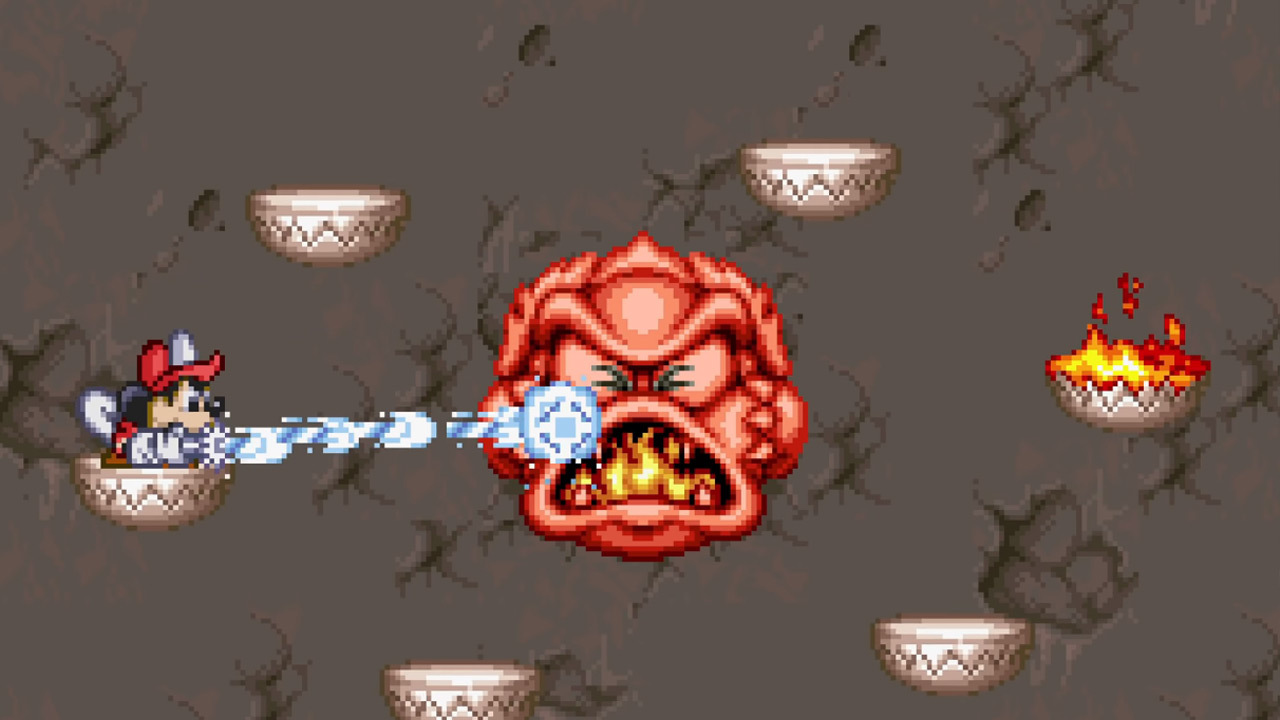
Obviously Sega couldn't hog all the Mickey for themselves. Capcom had its own Mickey Mouse game, which conspicuously made sure to say "Starring Mickey Mouse" right in the title, just like Castle of Illusion. Magical Quest took Mickey on a similarly magical journey, but this time Capcom added some of its own flavor with a range of varying costumes that would give Mickey special powers. There was a Wizard costume that let him shoot magical beams with a charged shot, a Firefighter costume that let him spray water, and a Mountain Climber costume that let him grapple vertically. The outfit element added a lot of variety to the platforming and puzzle challenges, and it was punctuated by the cute little touch of Mickey stepping behind a costume curtain each time you swapped. It was followed up by two sequels, The Great Circus Mystery Starring Mickey and Minnie, which was later retitled Magical Quest 2, and Magical Quest 3.
Darkwing Duck - 1992
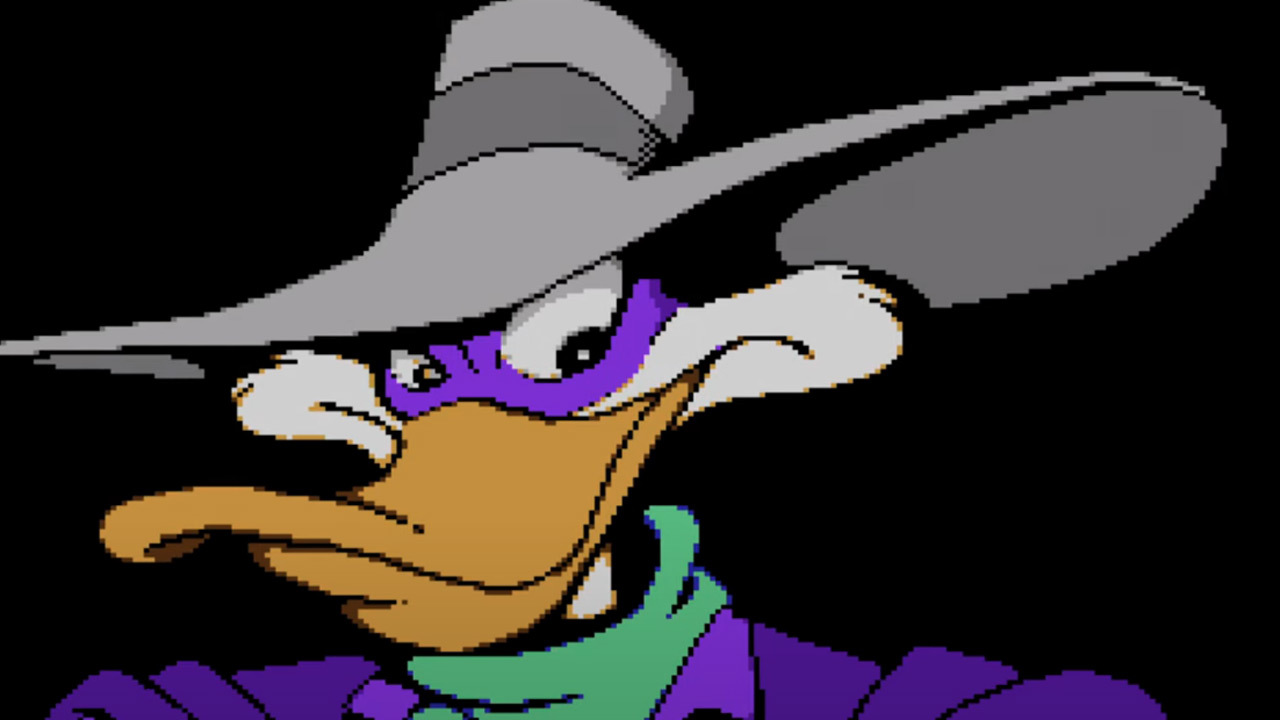
As all '90s kids know: when there's trouble you call D-W. This adventuring series might have been the Disney cartoon that lent itself the most to a video game, but it was a latecomer compared to many of Capcom's others. Darkwing Duck was a side-scrolling action game similar to the Mega Man series, with a sidearm that shot gas pellets to incapacitate enemies. He can collect various different types of gun elements as he makes his way through the stages, taking on the arch-villain chicken Steelbeak to save the city of St. Canard.
Aladdin - 1992
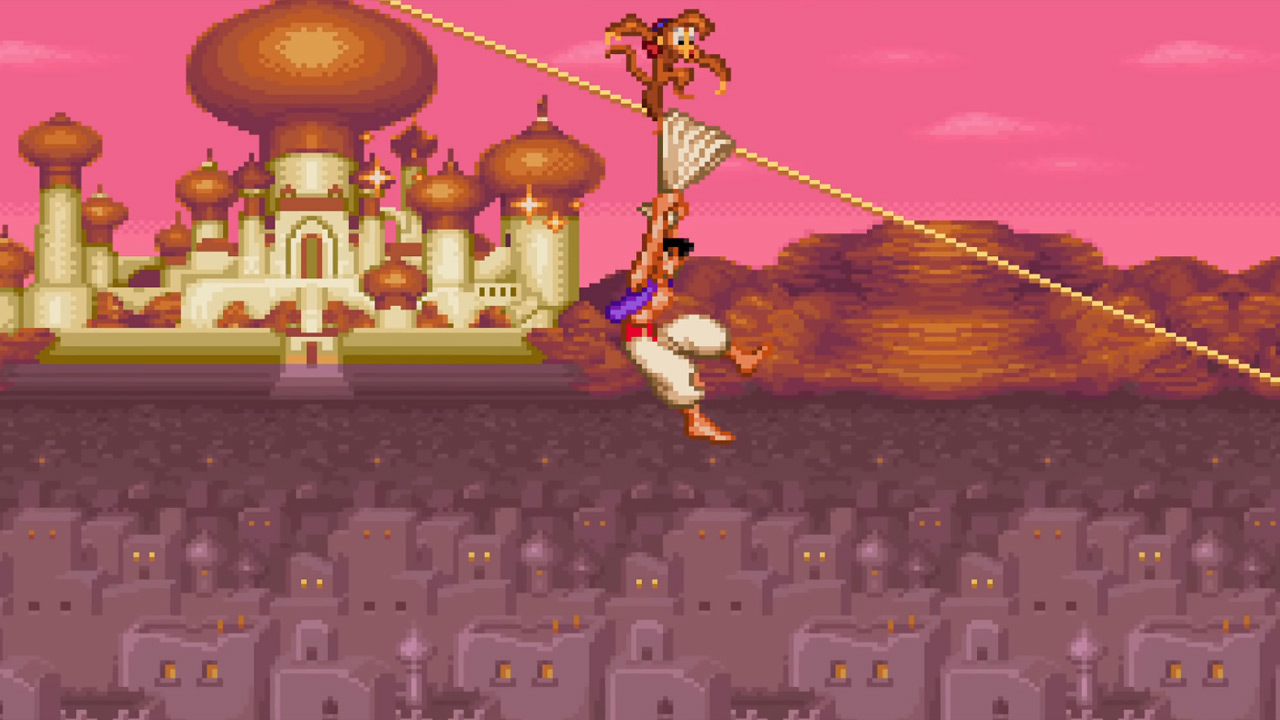
The Aladdin game may be the pinnacle of the 16-bit era of Disney games, and is still widely regarded as one of the best Disney licensed games of all time. The adaptation turned the down-on-his-luck street rat into a swashbuckling hero, complete with a sword. ("You idiots! We've all got swords!") Aladdin could toss apples at enemies, and the presence of Genie made for some fun fourth-wall breaking moments. But if Aladdin is remembered for one thing it's the silky-smooth pixel animation that looks impressive even by modern standards, and gave our favorite prince of a thief that extra layer of personality.
The Jungle Book - 1993

If some Disney licensed games owed a lot of their identity to contemporaries like Mega Man, The Jungle Book took a different approach and based itself almost entirely on Pitfall. It was a platformer in the classic sense, as Mowgli had to navigate environmental obstacles in a jungle full of things trying very hard to kill him. You swung from vines, bounced off tree branches, and avoided hazards like monkeys and, for some reason, baby birds. Thanks to the source material it did have a good assortment of boss fights, including a memorable encounter with Kaa the snake.
The Lion King - 1994

One of Disney's biggest and most prestigious animated films, The Lion King deserved a video game adaptation worthy of its name. What it got was a visually beautiful but ridiculously difficult game that no child was able to finish. The difficulty spiked early in this action platformer, which meant most kids never got past the wildebeest stampede or the kaleidoscopic "I Just Can't Wait To Be King" stage. A level select code lets players skip around to see all the good parts, including the dramatic finale. To be frank this one mostly makes the list for its place in history and its lovely animation, and if you play the compilation set you can save at any time, which may help make your way through the punishing difficulty.
Gargoyles - 1995

Amid the success of cartoon adventure shows with darker themes like X-Men and Batman: The Animated Series, Disney answered with its own gritty serialized show, Gargoyles. The show centered around magical warrior creatures who turned to stone during the daytime, reawakened from a thousand-year curse in New York City. It was ripe territory for a video game, and the game adaptation made use of it to have the lead character, Goliath, go from the Dark Ages to modern-day Manhattan. It lacked some of the lighter elements of the show, and only one playable character gave short shrift to Goliath's erstwhile family, but it captured the tone and heavily featured a floaty double-jump to imitate the gargoyles' winged abilities.
Kingdom Hearts - 2002

The crossover that launched its own dedicated franchise was a hit right from the start, even if its premise was as goofy as the cartoon dog that bears its name. Developed by Square Enix, the company best known at the time for its turn-based RPGs, this action-RPG mixed elements of Final Fantasy with Disney characters and worlds. The protagonist was an original creation, Sora, who found himself caught up in an epic story involving a dark wizard who wanted to consume all of the worlds in darkness. He was assisted on his journey by Donald Duck the wizard and Goofy the knight, as they searched for the missing King Mickey. The trio traversed around a variety of Disney worlds and met with iconic Disney characters like Ariel and Aladdin. It also utilized a unique real-time combat system with some RPG elements, which serves as a very close proto-example of what we've seen in recent Final Fantasy games. It was followed by several sequels, spin-offs, half-sequels, remasters, and more. Square has now announced Kingdom Hearts 4, which has not yet been given a release date.
Epic Mickey - 2010

With Disney's interest in traditional console games seeming to wane, Warren Spector won over the company with his pitch for a very different style of 3D platformer. The adventure game for Wii featured a more classic, mischievous Mickey Mouse and used the Wii Remote as a paintbrush. The real treat for Disney fans, though, was its story that served as a meta-commentary on Disney history. The chief antagonist of the game was Oswald the Lucky Rabbit, an actual old and unused Disney character. In the context of the story, Oswald was resentful that Mickey had taken over his spot as the recognizable mascot of the Disney brand. This marked the first time Mickey and Oswald had ever appeared together in anything, seeing as the plot revolved around the mouse replacing Oswald. The two made amends by the end and reunited for a sequel, Epic Mickey 2: The Power of Two, putting a happy end to the rivalry.
Toy Story 3 - 2010
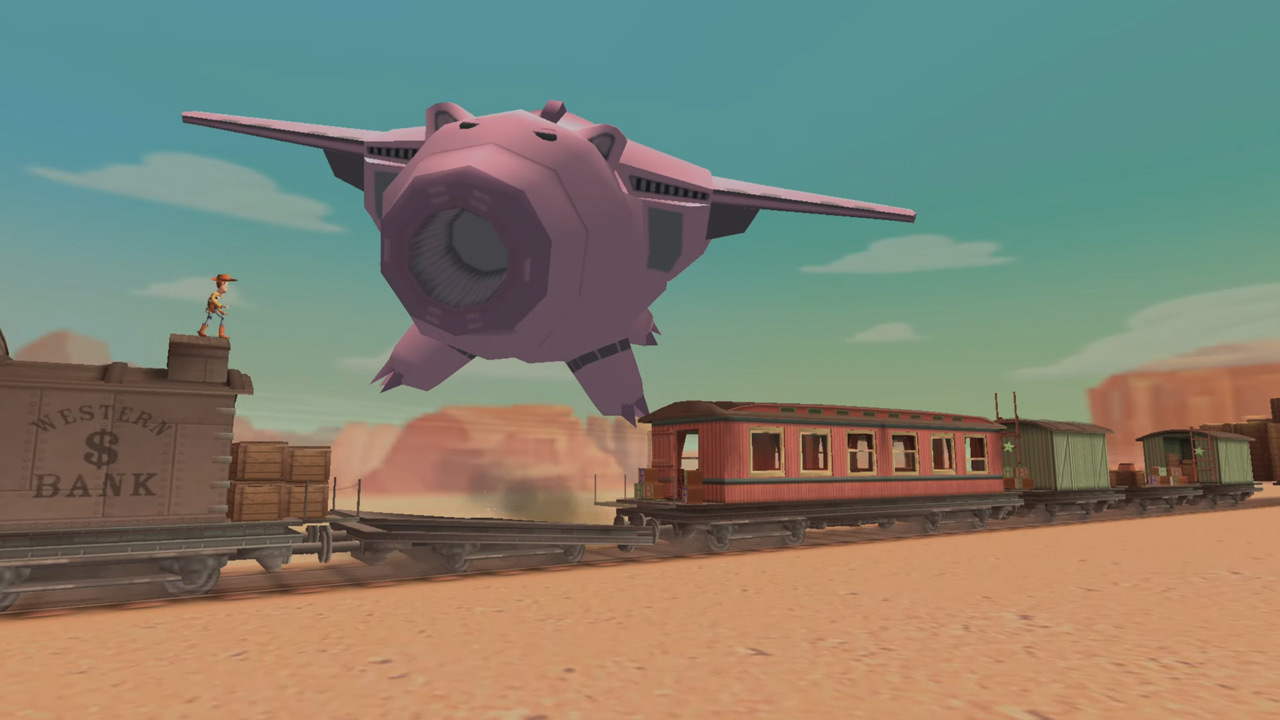
The history of Toy Story games is practically a walkthrough of the history of video games, from a fine action-platformer on SNES for the first game to the rudimentary 3D platformer on PlayStation for the second game. By the time Toy Story 3 rolled around, standard movie tie-in games were no longer the expected norm for video games. Avalanche Software made a game that functioned both as a retelling of the movie story, and a wild and experimental game in itself thanks to the new Toy Box mode. Toy Box let you customize the world to your liking and populate it with characters and props. It was a sandbox where you could experience the magic of just playing with your toys and favorite characters, and it served as a proof-of-concept for Disney Infinity.
Fix-It Felix Jr. - 2012
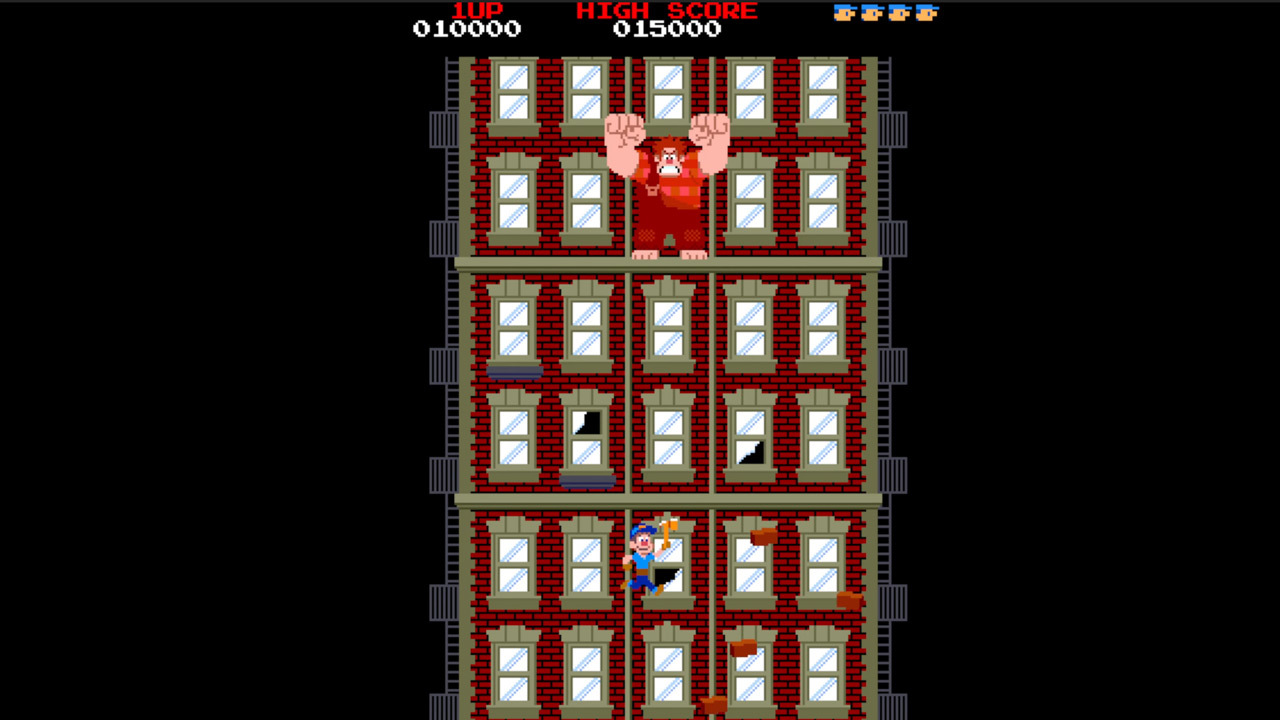
Obviously, a movie that is about video games needed its own video game tie-in. But rather than make a traditional tie-in game that retold the story of Wreck-It Ralph, Disney recreated the fictitious classic arcade game featured in the movie itself. Fix-It Felix Jr. is loosely based on Donkey Kong, as you use your magic hammer to repair sections of the building that have been wrecked by Ralph as you climb the tower to him. The little touches make it feel authentic, like the pixel art and the vestigial "Jr." that implies it's a sequel that overshadowed its predecessor. Different versions of Fix-It Felix Jr. were released, but the ultimate version has to be the actual, functional arcade cabinets produced as promotional materials.
Disney Infinity - 2013
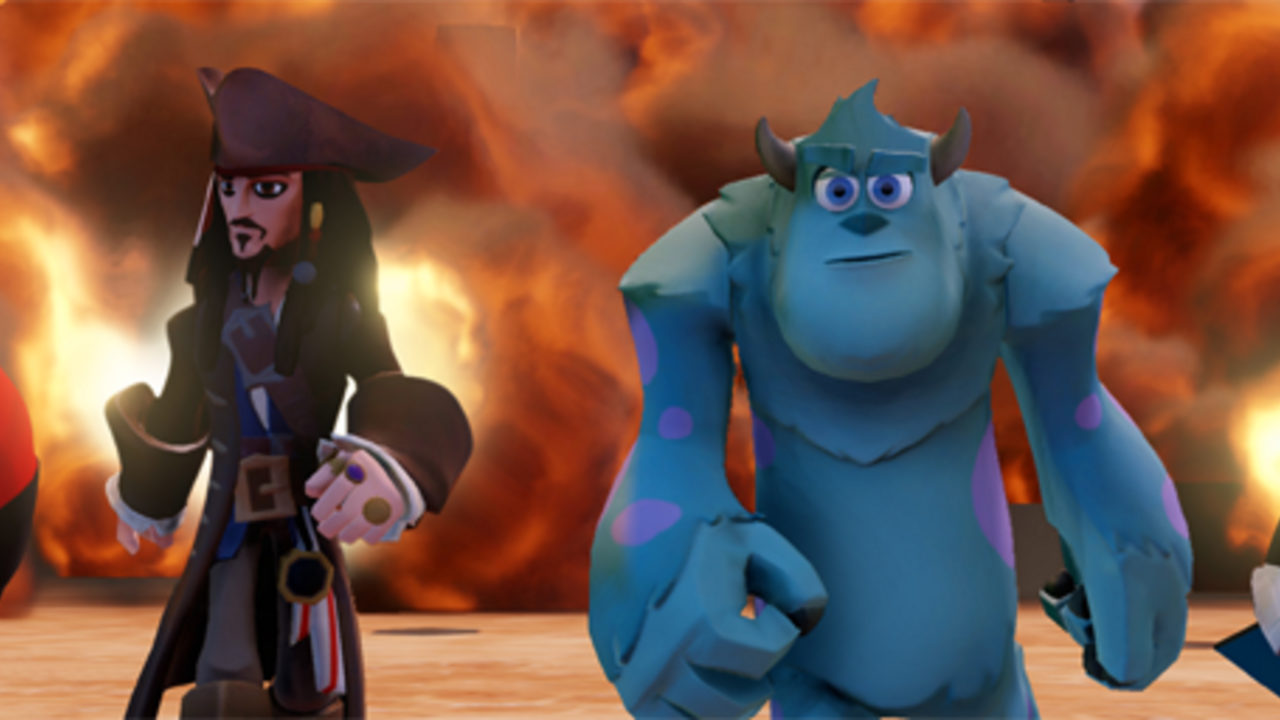
With toys-to-life games hitting big thanks to Activision's Skylanders franchise, Disney answered with its own version, Disney Infinity. The game featured a similar sandbox to the one found in Toy Story 3, along with bespoke adventures based on iconic Disney brands, including Pixar, Marvel, and Star Wars. It was followed by two sequels, but the basic functionality remained the same: you could place figurines on the base to unlock characters and missions. It tied together these extremely different properties and worlds with a cohesive, angular art style that looked fantastic. Its long-term plans were scrapped before their time, but the figurine art style has lived on in Disney's Toybox line of action figures.
Fantasia: Music Evolved - 2014
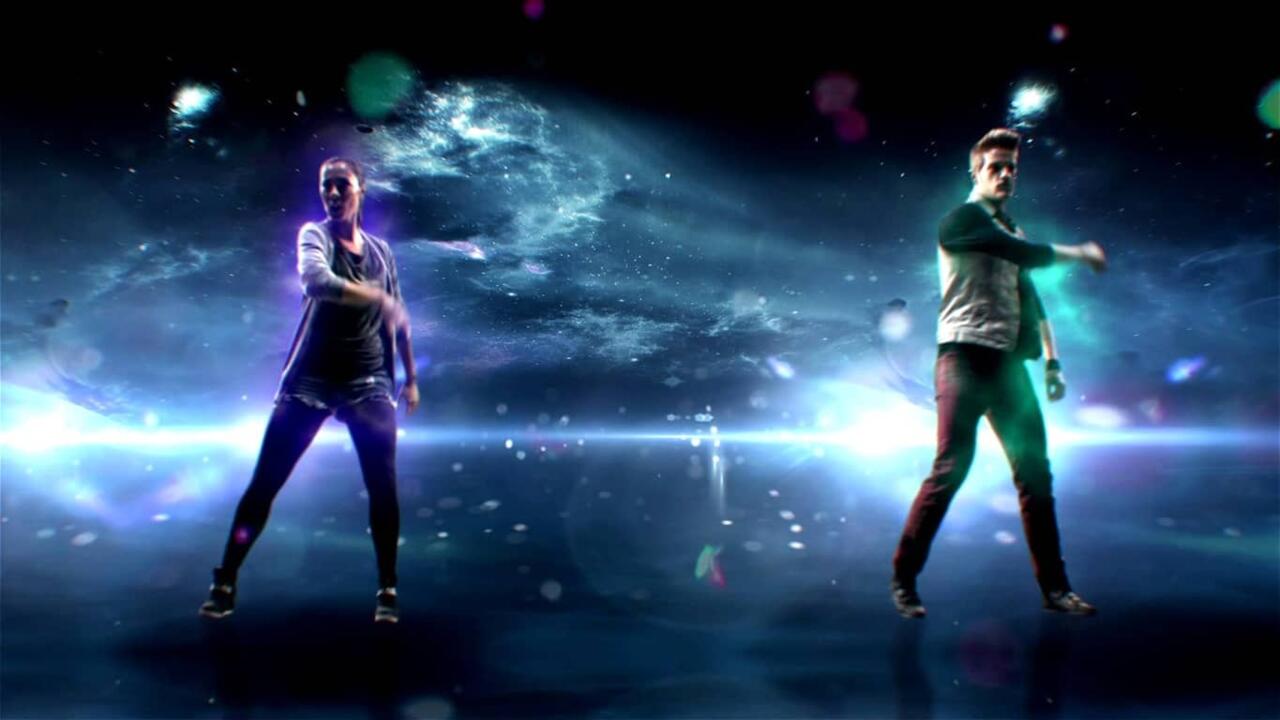
By 2014, Harmonix had built a reputation as the go-to studio for stylish rhythm games that paid respectful homage to the source material. So it was only natural that it was the studio tapped for a project based on the classic musical movies Fantasia and Fantasia 2000. It was built to take advantage of the Xbox Kinect, the motion-sensing camera controller, and had you interact with the music by waving your arms like a composer. It was more full-fledged than many other Kinect games and offered a uniquely tactile experience.
Kinect Disneyland Adventures - 2017
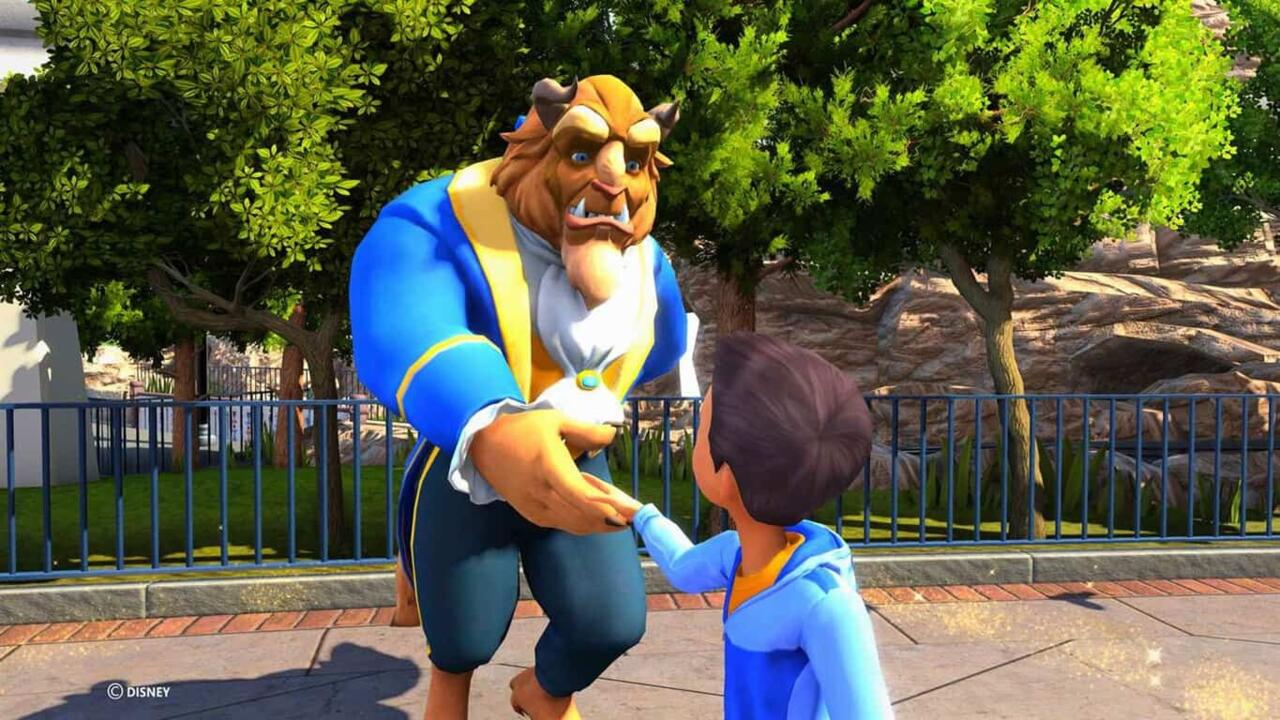
One of the only games based not on a movie but rather on the popular Disney parks properties, Disneyland Adventures was also created to take advantage of the Xbox Kinect. While the camera-based motion control didn't last much after this release, you can still play this with a controller. It's perfect for younger fans of Disney, as it lets you explore the park, take part in simple mini-games, and virtually meet up with their favorite characters. Older gamers might find the whole thing a bit dull, but put it in front of a little kid and watch the magic happen.
Lego The Incredibles - 2018

The Incredibles fans spent years waiting for a sequel, and when they finally got one in 2018 they also got a movie tie-in game. Lego The Incredibles applied the usual Lego formula to both Incredibles films, letting you collect little brick studs as currency and amass a huge roster of Incredibles characters, as well as cameo appearances from other Pixar movies like Woody from Toy Story and Sully from Monsters Inc. This was well after Lego games had come out for various other franchises, so it was a bit more of the same. Still, though, the Lego formula works for a reason, so it was a cute way to spend time with Mr. Incredible and the family.
Got a news tip or want to contact us directly? Email news@gamespot.com
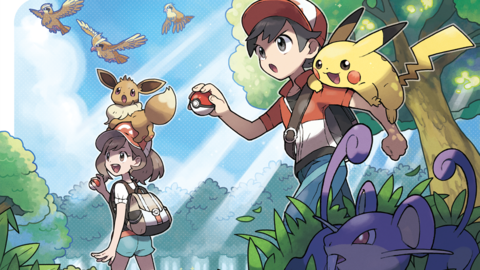


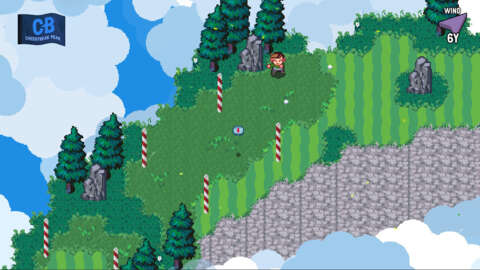



Join the conversation